Foreworld: A destroyer force dwarved by NATO
The Soviet Navy was the “poor parent” compared to the land and air forces during the cold war. At any moment for 43 years, the Soviet ground forces could unleash more than 20,000 tanks on the German plains and forest, and strike with thousands of attack jets all valuable targets in a couple of hours. However due to its particular maritime access, the Soviet Navy was less in position to harm NATO countries, especially in Europe. It was split between the northern fleet, reserved to SSBN and SSNs, one of the pillar of USSR nuclear deterrence. Her only strategic western access was in the Baltic. In the black sea, the navy was trapped between a NATO allied Turkey, Italy, which both had sizeable navies, plus a permanently based USN task Force. In the Pacific, the Soviet Navy had to face Japan, and after 1939, China as well.

Soviet destroyers, in particular missile destroyers built from 1960, had to face many challenges in this context: Protecting Soviet merchant traffic, one of the largest of the time, which became a vital asset as its network of decolonized, sympathetic unaligned countries, potential customers became a thing. But moreover assist its cruisers, notably its missile cruisers. Before that, mass-produced destroyers such as a Skoryy class were used for general purpose missions but ASW warfare, especially in the Baltic. This stayed important as the USN submarine fleet was a massive, threat in the Atlantic, added to other NATO member’s own conventional submarine fleets.
ASW warfare was however mostly left to specialized vessels such as Frigates, whereas Destroyers took on more versatile roles, almost be seen as alternative cruisers just like for NATO. The last cruisers in Europe (France, Italy and UK notably) were scrapped in the 1970-80s, therefore the bulk of 1970s fleets rested on missile Destroyers, often specialized, AA or ASW. The Soviet Sovremenny and Udaloy class were good examples of this. On paper, they were versatile ships, able to deal with any threat, surface, air and underwater, but at the same time, gearing to some specialized task. The former were more AA/AS ships, the latter were ASW-specialists. They were large, almost the tonnage of cruisers, and were classed as such by some authors (Like john Gardiner for Conway’s).
However for the most sensitive years of the Soviet navy, the 1960s decade, Kashin class destroyers really formed the bulk of this type. With their very high speed of nearly 40 knots, flush-deck hull, relatively small tonnage at 4,400 tonnes they were quite a match for the existing ships of the USN, the older Farragut and Charles F. Adams class.
But basically the Sovyetsky Voyenno-Morskoy Flot main goals were to disrupt NATO maritime supply lines and show the flag to developed countries around the world, whereas in WW2, it was mostly geared up for defense, in-bewteen a green and blue water navy.
From conventional to missile destroyers
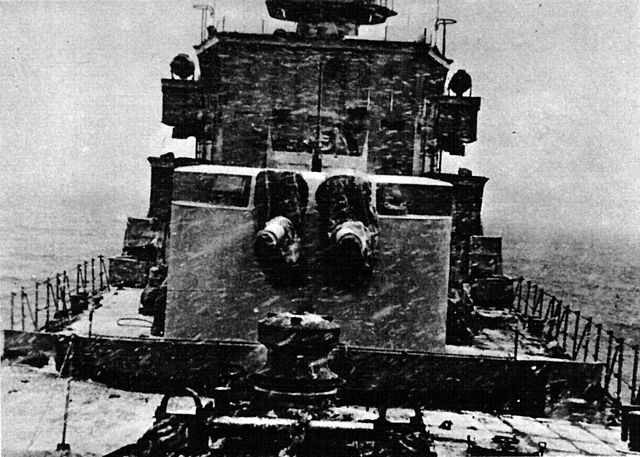
The Soviet Navy during WW2 had little occasion to launch a sizeable fleet against German assets in the Baltic. After the surprise of Operation Barbarossa, air attacks quickly damaged the most important ships of the fleet, notably capital ships and cruisers, and destroyers rapidly took a more active role, in the Baltic notably for ASW warfare, laying mines and patrolling. The Ognevoi-class was the last wartime design completed at that time and after the war. They some lessons from the conflict and retained their roles, but improved on the mass-produced Type 7, by introducing a larger hull able to deal with heavy weather and enclosed turrets, with improved 130 mm guns and better AA. On 24 ships ordered, only 11 ere completed, the last in 1948. They formed a basis for a new generation of destroyer which was still conventional, but pushed forward the concept of blue water navy fleet destroyer like never before.
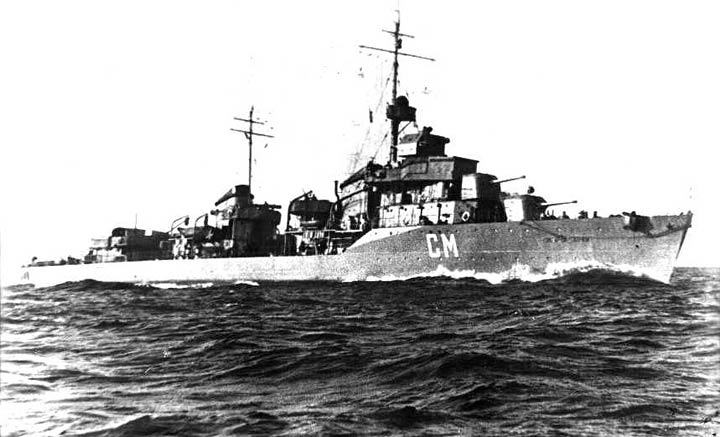
A WW2 Type 7, Smyshlenyy, Storozhevoi class.
These were the Skoryy class, really to place on part with other mass-production programmes of the early cold war Soviet Navy, during the Stalinian era. They were built in mass, 70 ships, from 1949 to 1953, but in appearance were still very conventional, with a forecastle, alternating structures and torpedo tubes banks, twin 130 mm turrets fore and aft, and a powerful AA. Top speed was still about the same, 37 knots, but they had a longer range at 4700 vs. 2900 nm and carried two 85 mm (3.3 in) and seven 37 mm (1.5 in) AA guns. This class formed the backbone of the soviet navy destroyer force, until the 1980 were the last were discarded, equipped with more modern 57 mm AA guns and RBU 2500 ASWRL.
17 were affected to the Baltic, 18 to the Black sea, 18 for the Northern fleet and 17 for the Pacific fleet. They operated as escorts to the Chapayev and Sverdlov class cruisers and also corresponded to the Whiskey class submarine construction program (250 submarines), the largest submarine program worldwide at that time.
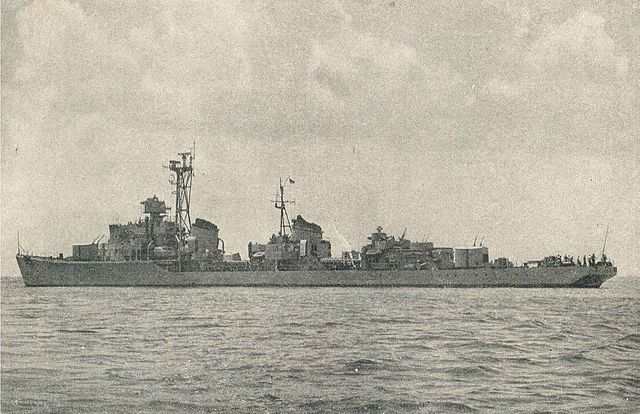
RI Siliwangi. Indonesian Skoryy clas DDs were the last in service.
of course the introduction of missiles on a cruiser, the Kynda class, offered new possibilities, and the idea of installing missile on a destroyer gradually made its way, but it was understood the size of destroyers and bulky antiship missiles at that time made them not good platforms, and lighter SAMs were rather planned for destroyers to procure an escort. It was transitional. The Neustrashimyy program was to succeed to the Skoryy with a host of innovations, but mass-production was eventually cancelled for a lighter and cheaper version, which became the Kotlin class.
The latter became the staple of Soviet destroyer force in the 1960s. They were still conventional, as they shared the same main twin turrets fore and aft, and alternating quintuple torpedo tubes banks and structures, with a modernized AA of 45 mm in quad mounts, but quite a powerful array of radars and guiding systems and modern sonar for their ASW launchers and racks. Soviet destroyers looks rather indigents in the matter at that time: No helicopter, no missile-carried ASW charge or torpedo. However soon, the famous RBU system was introduced (see later). In addition, many of the Kotlin class vessels were modernized several times and variants were tested;
-Project 56PLO, Kotlin Mod. had enhanced ASW capabilities with the addition of RBU launchers.
-Bravyi in 1962 was converted as missile DD, with a S-125 Neva, the SA-N-1 ‘Goa’ SAM system.
-1970 retrofit or “Missile Kotlin” known by NATO as Kotlin SAM class (Project 56A) led to a single ship, sold to Poland, later upgraded with the Volna-M (SA-N-1B).
The transition comprised to Kotlin-derived destroyers, often confounded because of theor NATO names: The Kildin and Kanin. They were note the same class. The Kildin were the first missile destroyers fitted with antiship missiles, carrying the SS-N-1. To gain time, the Kotlin class was chosen as a basis, but four ships were heavily modified. They were known as Project 56EM (prototype, Bedovyy), and Project 56M for her sister-ships. They served until 1990, modernized in between. However in parralel, Project 57A was the first true attempt to devise a missile destroyer.
For this, the Kotlin hull was judged too small, and larger ships were designed. NATO gave them the codename Krupny; But they were known by specialists as the Kanin class.
Their main task was antiship warfare and for this, they were armed with SS-N-1 anti-ship missiles. This forced the sacrifice some torpedo tubes and main guns. The missile system was stored aft, and they possessed four quadruple 57 mm (2.2 in) AA guns and two side triple 533 mm (21 in) Torpedo tubes later upgraded to fire ASW torpedoes.
Armament of Soviet destroyers
Naval Guns
Twin 130 mm (5.1 in) guns: Skoryy, Neustrashimy, Kotlin
Twin 130 mm (5.1 in) AK-130 guns: Sovremenny
Missiles
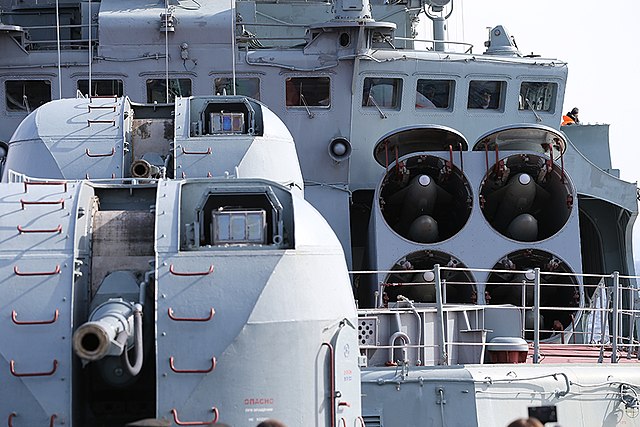
-SS-N-1 anti shipping missile launcher (Kildin, Kanin, Kashin)
-SS-N-2 anti shipping missile launchers (Kildin)
-SS-N-22 ‘Sunburn’ anti-ship missiles (Sovremenny)
-SS-N-25 ‘Switchblade’ (Kashin)
-SA-N-7 ‘Gadfly’ surface-to-air missiles (Sovremenny)
-SA-N-9 ‘Gauntlet’ surface-to-air missiles (Udaloy)
-SS-N-16 ‘Stallion’ anti-submarine missiles (TT launched, Udaloy)
-SS-N-14 ‘Silex’ anti-submarine/anti-ship missiles (Udaloy)
AA Guns
-Single mount 85 mm (3.3 in) AA guns (Ognevoi)
-Single mount 37 mm (1.5 in) AA guns (Ognevoi)
-Twin 76 mm (3 in) AK-726 guns (Kotlin)
-Twin 57 mm guns () AA guns (Skoriy)
-Twin mount 45 mm ( in) AA guns (Skoryy, Neustrashimy, Kotlin)
-30 mm (1.2 in) AK-230 guns CIWS (Kildin, Sovremenny, Udaloy)
-Kashtan CIWS
-Twin 21KM AA guns (Udaloy)
Torpedo Tubes
533 mm (21 in) triple (Ognevoi), quadruple, quintuple
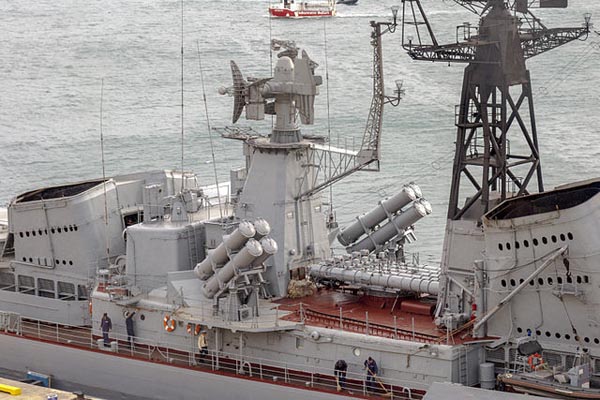
Smetlivyy in Valletta, shiwing its battery of SSNs and quintuple TTs
ASW weaponry
-ASW depht charges (ww2 model)
-RBU-2500 anti-submarine rocket launchers
-RBU-6000 anti-submarine rocket launchers
-RPK-8 Zapad ASWRL
-RBU-1000 anti-submarine rocket launchers
Onboard aviation
-Ka-27 series helicopter (Kildin, Kashin)
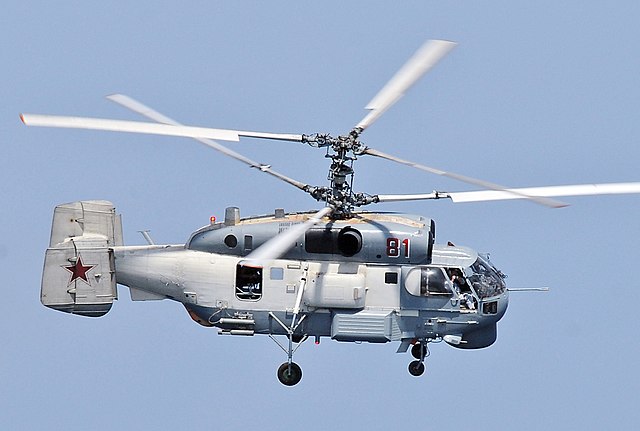
Sensors of Soviet destroyers
Radars:
-Gyus-1, Ryf-1, Redan-2, Vympel-2 (Skoryy)
Fut-N (air) Ryf (surface) (Neustrashimmy, Kotlin, Kildin)
-Angara/Head Net (air), Zalp-Shch (guidance) Neptun (surface) (Kanin, Kashin)
-Air target acquisition radar Top Steer, 3 Palm Front, 6 Front Dome, 1 Kite Screech, 2 Bass Tilt (Sovremenny)
-MR-760MA Fregat-MA/Top Plate 3-D air search radar, MR-320M Topaz-V/Strut Pair air/surface search radar
-2 MR-360 Podkat/Cross Sword SA-N-9 SAM control, 2 3P37/Hot Flash SA-N-11 SAM control, Garpun-BAL SSM targeting FCS (Udaloy)
Sonars:
-Tamir-5h (Skoryy)
-Pegas (Neustrashimmy, Kotlin, Kildin)
-Pegas2, Titan2 (Kanin, Kashin)
-LF*, 8 CME Bell, 2 decoy launchers (Sovremenny)
*Active and passive under-keel sonar
-Horse Tail LF VDS sonar and Horse Jaw bow mounted LF sonar (Udaloy)
Decoys are of the type 2 PK-2 decoy dispensers (200 rockets) (Udaloy)
Or of the PK-10 types (ten on Udaloy)
Electronic warfare:
Bell Squat jammer, Bell Shroud intercept, Bell Crown intercept (Udaloy)
Conventional soviet destroyers
 Ognevoi, the last WW2 Soviet destroyers (1940)
Ognevoi, the last WW2 Soviet destroyers (1940)
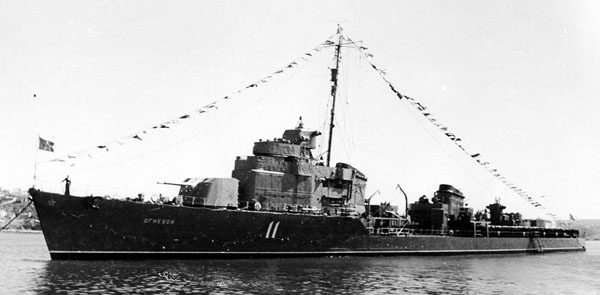
“The specification (TTZ in Russian) for these ships was issued by the Naval staff in November 1937. The design work was done by Zhdanov Yard in Leningrad under the leadership of A. Yunovidova and approved by the government in 1939.
Hull strength was significantly increased and the hull was enlarged compared to the Project 7 ships. Longitudinal framing was used and hull plating was thicker than the Project 7 ships. Hull height was increased giving extra free board.
The machinery consisted of two boiler rooms and two engine rooms similar to the Project 7U destroyers but in less cramped spaces. Electricity generation capacity was increased to two 100 kW (130 hp) plants and two 50 kW (67 hp) plants. An alternative design Project 30A using super-heated high pressure machinery based on American designs was projected but not built.
The armament was housed in two enclosed splinter-proof and weatherproof turrets in ‘A’ and ‘Y’ positions. This was a significant advance over the open mountings used in the Project 7 ships. The B-2LM turrets were introduced in the Tashkent class and proven successful in service but had no anti-aircraft capability. Anti-aircraft armament comprised two 85 mm (3.3 in) guns in a twin mounting in ‘X’ position and six 37 mm (1.5 in) guns in single mountings. The ships also carried two sets of quadruple torpedo tubes and 50 mines.
The ships were fitted with air warning, surface search and gunnery control radars and sonar after the war. 24 ships were ordered in 1938–1940 but the programme was disrupted by the German invasion in 1941. The ships being built in Nikolayev were demolished before launch or evacuated incomplete while those built in other yards were suspended for the duration of the conflict. Some of the intact ships were completed after the war to a modified design (K for korrektirovany – corrected). ”
Skory class destroyers (1949)
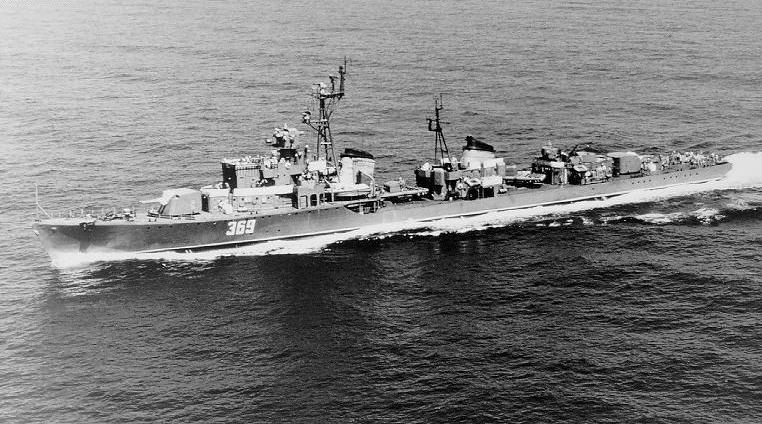
The Skoryy was somewhat Stalin’s answer to the large American series of standardized Fletcher and Gearing class destroyers. It was essentially a development of the 1940 Ognevoi class, but they incorporated many of the technologies inherited from German ships captured or transferred as war damage.
These ships were longer and wider than their ancestors, but retained a traditional hull with two decks. their general design also remained very classic, with benches of torpedo tubes distributed between the two chimneys and the forecastle, a more modern artillery in double turrets, and a powerful DCA, according to the standards imposed in 1944-45.
Their design began in October 1945, the design being approved in January 1947. The structure of their hull and their construction also marked a turning point. In addition, this reinforced hull was pre-assembled in 101 sections to speed up construction. This is how most of them were assembled in just over a year.
51 destroyers, including the first, the Smeliy, put on hold in May 1948, and the last, the Ozhestochenniy, in March 1953. Their behavior at sea was again criticized in heavy weather, the artillery being blinded by the swell and the speed reduced to 28 knots. In addition, their maneuverability was poor and their stability could be improved (counter-hulls were added quickly).

Project 30-bis Skoryy class destroyer Ser’yoznyi in the Mediterranean on 28 August 1968.
Their original DCA consisted of a twin 85 mm gun mounts and seven 37 mm in single carriage, but in 1952 the new standard became for all 8 of 37 mm in four double carriage and between 2 and 6 of 25 mm (in place of those of 85 mm). The 130 mm had 150 shots each, the 85 mm 300. The sonar was also replaced by a new model. They took 85 tonnes, in particular to make the hull even heavier in order to counter the pitching. From 1957, a modernization gave them a new role, mainly ASM: The modernization concerned the removal of their heavy front rangefinder, the central TLT bench, and the addition of 2 RBU-2500 rocket launchers, the DCA being replaced by 5 single cannons of 57 mm.
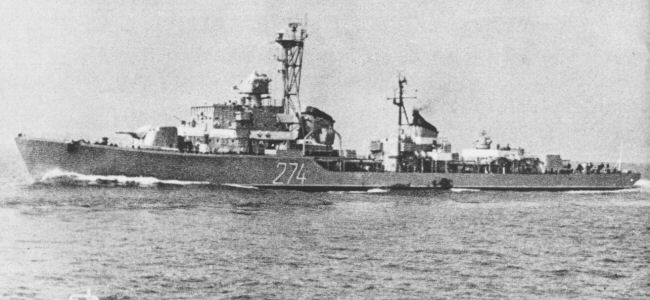
Orp Wicher, one of the two Polish destroyers transferred from the Baltic fleet

Skoriy – Variants of the destroyers
From 1956, transfers began: Egypt (6), Indonesia (7). The rest were disarmed between 1973 and 1987.

Specifications
Displacement: 2316-3066t, 8565t FL
Dimensions: 120.5 x 12 x 3.9m
Propulsion: 2 shafts, 4 turbines 60,000 hp. 36.5 knots.
Crew: 286
Electronics: Radars Gyus 1B, Ryf-1, Redan-2, Vympel-2, Sonar Tamir 5H.
Armament: 4 x 130 mm (2×2), 1×2 x 85 mm, 7 x 37 mm, 10 x 533 mm (2×5) TTs, 2 x ASW, 2 DCT 52 DCs.
 Neutrashimyy (1952)
Neutrashimyy (1952)
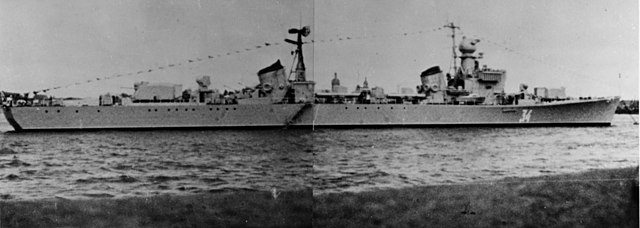
This was a destroyer designed as the prototype for an large production run (Soviet Designation Project 41), which never took place as she was considered too large and expensive. A modified design called the Kotlin class was chosen instead. NATO reporting name was the Tallinn class.
Built at Zhdanov Shipyard in Leningrad she was laid down in 1950 and was Launched 29 January 1951. Her trials campaign started on 28 January 1952 and she was ultimately commissioned on 31 January 1955, in the Baltic Fleet. She was ultimately decommissioned in February 1974.
She had a “fush deck” hull, in contrast to the previous forcastle-built Skoryy, and the final development of the “classic”, or conventional destroyer as defined since 1910. It foreshadowed the Kotlin class but was essentially a larger and improved Skoriy.
The flush deck arrangement allowed the superstructures to be NBC proof. She also had air conditioning, improved heating for missions equatorial waters. They also had limited armour, in the range of 10–20 mm plates (0.39–0.79 in)) around the bridge, gun mountings. The hull on trials showed problems of seaworthiness and the shape of the bow proved problematic, their forward deck was very wet in high seas.

Propulsion: Innavative high pressure steam turbine, boilers and engine rooms in alternating spaces. The boilers on forced draft worked at a pressure of 64 kg/cm2 (910 psi). No pre-heating and 20% fuel economy compared to the Skoryy-class. This powerplant was therefore ised on the Kotlin and subsequent classes.
Armament Two enclosed dual purpose 130-millimetre (5.1 in) stabilized on 3 axes, located in “A” and “Y” positions. The AA comprised four quad 45 millimetres (1.8 in) automatic guns (brand new pattern). ASW: Two RBU-2500 mortars, 2×5 torpedo tubes, 50 mines.
Sensors: Ryf surface search radar, Neptun Navigation system, Fut air search radar, Pegas Sonar. The early combat information/Control system was Plashnet-41.

Specifications
Displacement: 6500t, 7500t FL
Dimensions: 164.93 x 17.22 x 5.03m
Propulsion: 4 shafts Parsons turbines, 4 Yarrow boilers, 54,000 hp. 30 knots.
Armor: 51 mm bridge and turrets, 76.2 mm belt
Crew: 556 + 60 cadets
Armament: 9 x 152 mm (3×3), 4 x 102 mm, 8 x 40 mm Bofors, 6 x 533 mm TTs (2×3)
 Kotlin class destroyers (1958)
Kotlin class destroyers (1958)
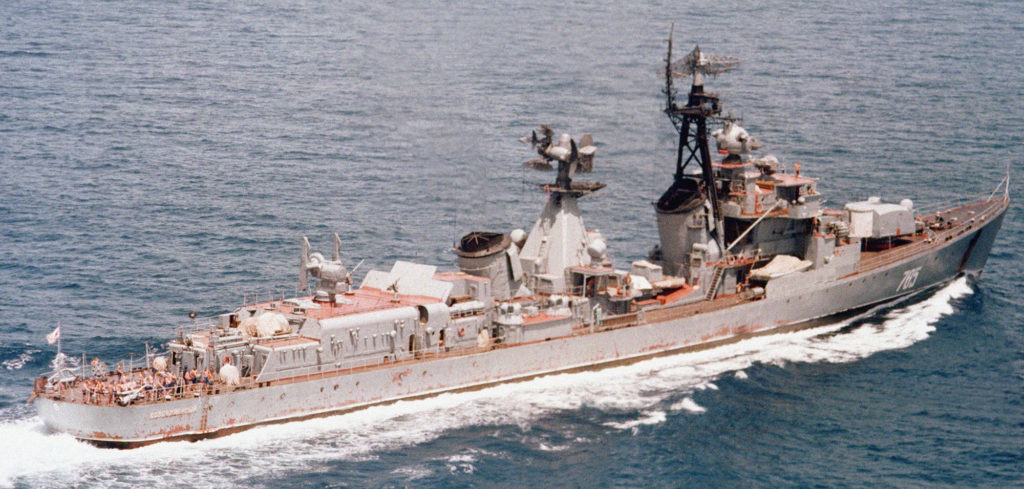
The Kotlin (project 56) are the first “real” post-war Soviet destroyers if we consider the Skoriy as a continuation of the Ognevoi and pre-war conventional designs since 1936. The Kotlin’s prototype was Neutrashimyy (or Tallinn, project 41-1951), an improved “flush-deck” variation of the Skoriy. A specification from 1951 mentioned an improved version of the type 41. The first measure was to reduce the excessive displacement of the first, in order to improve speed, from 36 to 39 knots, even if it meant sacrificing autonomy by reducing the fuel tanks size. They had also new, lighter torpedo tubes and improved automatic 45 mm AA guns.
100 units were planned according to the initial program, but in reality it was stopped at the 27th hull in October 1955. The next project was carried out on the same hull, but converted as the first Soviet missile destroyers, the Kildin class (1955, project 56M). Plans of the Kotlin were modified before launching, the hull was reduced, but had the same engine as the Tallinn class, while the bow was raised. To gain weight, the hull otherwise was partially built in aluminum and magnesium, while more modern machines gave them 72,000 hp instead of 66,000. From the start, they were fitted with rudder stabilizers, and four-blade propellers. All these modifications contributed, in the opinion of all Russian sailors, to excellent destroyers, which also explains their longevity in service, 1987-1990 for the most part.
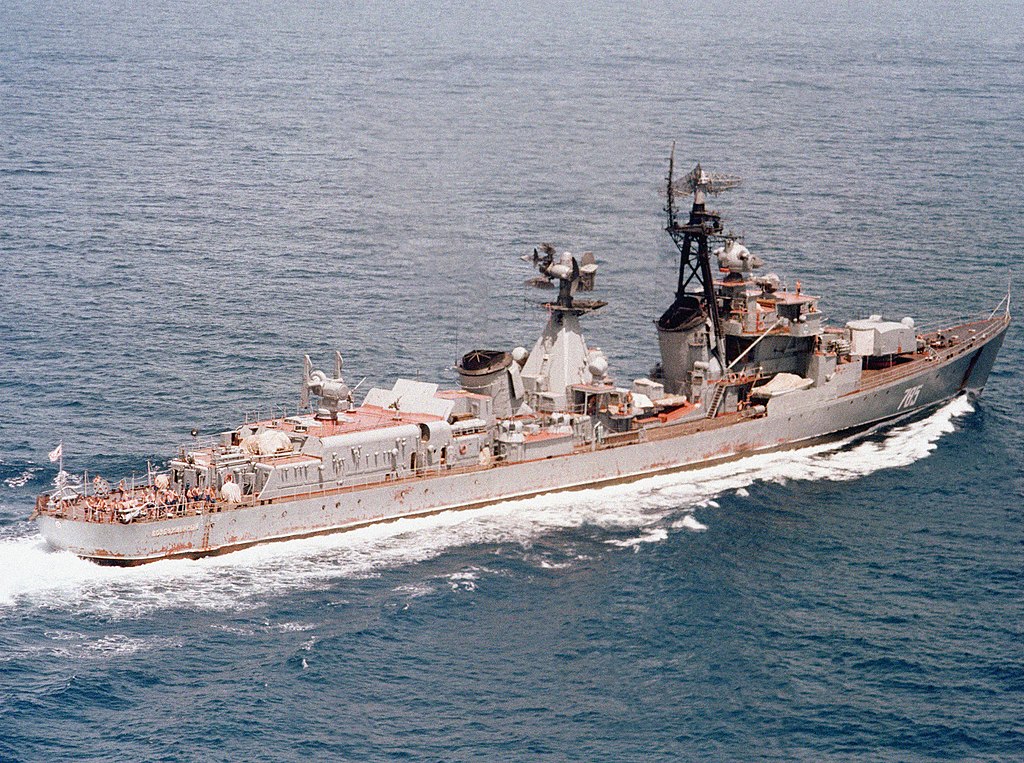
They were stable platfoms and “dry” because of their reedesigned bow, were light, unusually fast for destroyers at that time (up to 42.9 knots in trials). They kept very high speeds until the end of their service.
ASW Coversion: 12 ships were modified in 1958, as ASW conversions: The removal of their rear TT bank, addition of deep-charges charges and DC throwers, plus two rocket launchers of the RBU2500 and two of the RBU 600 types. The remaining torpedo tubes bank were modified to launch ASW guided torpedo models.
In 1959, Bravyy was modified to receive a SA-N-1 missile launcher which it tested until 1963, and which was followed by 8 similar modernizations in 1969-71. In the end, there remained 7 unchanged units, equipped only for three of them with helicopter platforms at the rear.
The Kotlin units and their modified versions ASM and AA, were withdrawn from service just before 1990 (1985-89) for 21 of them, there were still 4 in 1990, withdrawn from service two years later. Currently, these ships and the Kildins no longer exist.

Specifications
Displacement: 2660-3230t FL
Dimensions: 126.1 x 12.70 x 4.19m
Propulsion: 2 shaft turbines, 72,000 hp. and 38 knots.
Crew: 284
Electronics: Radars Fut-N, Ryf, Sonar Pegas-2b.
Armament: 4 x 130 (2×2), 16 x 45 (8×2), 10 x 533 mm (2×5) TTs, 6 ASW DCT, 2 DC racks, 48 grenades, 50 mines.
Soviet missile destroyers
 Kildin class missile destroyers (1955)
Kildin class missile destroyers (1955)
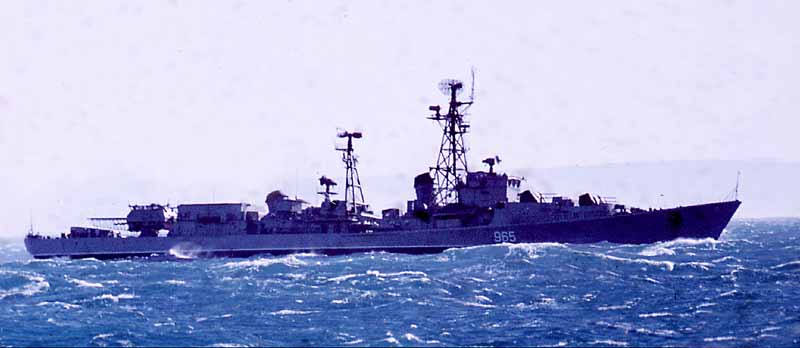
Kildin class Neuvolimyy off morocco, January 1970
Naval authorities were particularly happy with this Kotlin class, marked in particular by excellent speeds. Blagarodnyy, for example, made 42.9 knots during the tests and overall, these ships could still spin 36 knots after 10 years of maintenance-free service. However, these were conventional destroyers and the committees were pushing for the adoption of missile-launching destructors as quickly as possible. The Bedovyy was modified in this direction, with a KSSHch or SSN-1 (NATO) anti-ship launcher at the rear, completely modified. The Kiparis fire guidance system was also installed. It was class 56M known by NATO as “Kildin”.
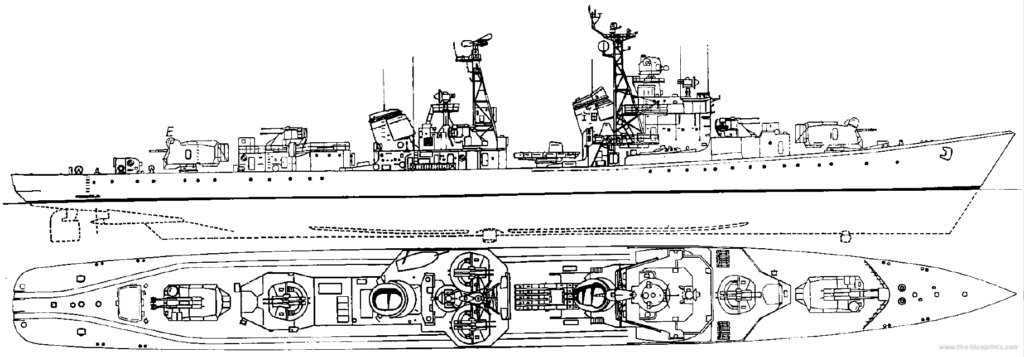
Blueprint – Naporystyy in 1966
After the success of the first in 1958, the last three hulls of “Kotlin” were put on hold in 1956 and 1957. They were launched on modified plans in 1957-58 and served until the end of the Cold War. A fourth was started, Neukrotimy at the Komsomolsk-sur-l’Amour Shipyard, then canceled, priority being given to the larger Krupny. Three were modernized in the 1970s to receive a new anti-ship system, four SSN-2 individual launchers placed on the sides while two 76mm fast cannons took place at the rear.
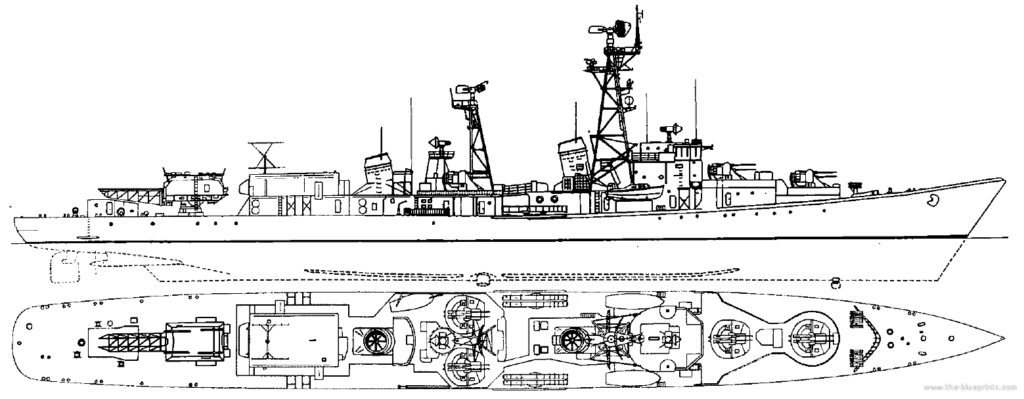
Specifications
Displacement: 2850-3340t FL
Dimensions: 126.1 x 12.70 x 4.19m
Propulsion: 2 shaft turbines, 72,000 hp. 39 knots.
Range: 3,900 nautical miles (7,200 km) 14 knots (26 km/h)
Crew: 19 + 251
Electronics: Radars Fut-N, Ryf, Kiparis, Sonar Pegas-2b.
Armament: 1 SS-N-1 SSN, 16 × 57 mm (4×4), 4 × 533 mm TT (2×5), 2 × RBU-2500 (128), 2 × RPK-8 Zapad/RBU-6000 (12) ASW
 Krupny class missile destroyers (1959)
Krupny class missile destroyers (1959)
The Krupny, project 57B, were new destroyers, issued from Kotlin standards but equipped with missile launchers. They were among the first of their kind in the world, defined in 1955, a project then modified until 1958, when the first was built. The hull was that of the enlarged Kotlin, but with special NBC treatment.
Putting their main difference lay in their armament, a double anti-ship missile launcher with 12 vectors in reserve, KSShch (SS-N-1), which was quickly disappointing. They also carried a Kamov Ka-15 “Hen” observation helicopter on their rear runway, but without a hangar to house it. The ASM torpedo tubes were triple and carried over to the sides. As early as 1965, there was talk of modifying them into ASM destroyers (“Kanin” conversions).
Kanin conversion
In this new configuration, they received a new quintuple bank of ASW tubes in the central position (project 57PLO), also with 2 ASM RBU 6000 rocket launchers with 213 vectors in reserve, a Ka-25PLO helicopter equipped with three AT-1 acoustic torpedoes or 12, 24 or 144 ASM PLAB grenades of different types, capable of implementing 72 standard buoys, and 30 of radar relays and markers.
These Kanins were also equipped with a double SA-N-1 missile launcher ramp with 32 vectors in reserve, in place of their SS-N-1 missiles. These modifications also extended to propulsion with new more powerful diesels, the hull modified to improve its acoustics, lengthened to 140 meters, the displacement passing to 3700 standard tons and 4500 tons PC.
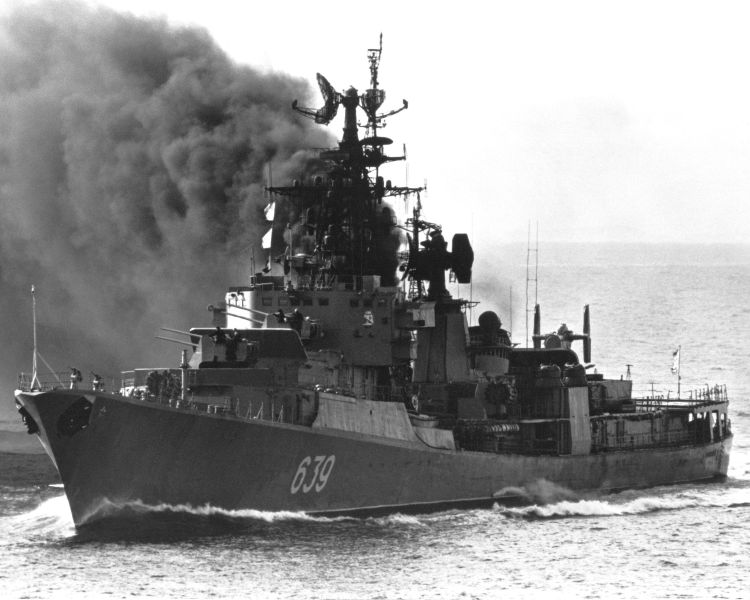
These 8 “Kanin”, ex-Krupny, launched in 1959-61, completed in 1960-61 and modified in 1956-67, were still in service in 1987. This year, the first two were withdrawn from service, followed by two others in 1988, the remaining four being active in 1990. That same year, one of them was struck off the lists, followed by one in 1991 and the last two in 1993.

Specifications
Displacement: 3500-4192t FL
Dimensions: 139 x 14.84 x 4.20 m
Propulsion: 2 shafts turbines, 4 SHT boilers, 72,000 hp. 34.5 knots
Crew: 310
Electronics: Radars Head Net, fire control Zalph Schch, Neptun navigation system, Sonar Pegas-2b.
Armament: 2 SSN1 (16) SSNs, 16 x 45mm (4×4) AA, 6 x 533 mm ASW TTs (2×5), 2 LR RBU-2500 (128).
 Kashin class missile destroyers (1964)
Kashin class missile destroyers (1964)
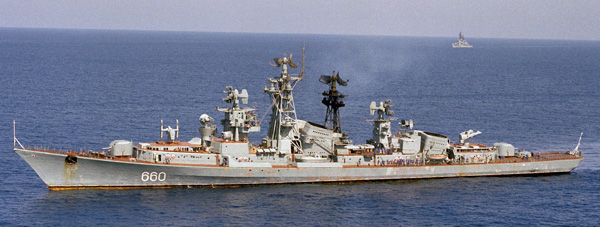
These vessels were the standard Soviet destroyers of the 60s and 70s. Versatile, with a hull always with a continuous deck, and designated in 1956 to replace the Kotlin and frigates of the Riga class. They were a new kind of escort capable of dealing with modern submarines and jets flying close to the waves and offering an umbrella against anti-ship missiles. They were the first large Soviet ships (and in the world) to use gas turbine technology. Their design was finalized and approved by Grand Admiral Gorshkov at the end of 1957, but construction of the first one was started only in 1962 in Zhdanov. The others will be partly built in Nikolayev.
It was a design so innovative that all their equipment and armaments had to be redesigned and adapted, and from the planned 3200 tonnes, we went to 3400. Their gas turbines were a notable success, allowing them to free up, that conventional high pressure turbines failed to achieve, had a longer lifespan, generated more electricity. moreover, the thermal signature had been treated by mixing with the extraction of the chimneys the emanations “cut” by cold ventilated air. However, one of the units concerned, the Komsomolets Ukrainy, first in the class, received the new classic M3 turbines for testing, and managed to test at 35.5 knots. Later, the Prozorlivy managed to reach 39.75 knots.
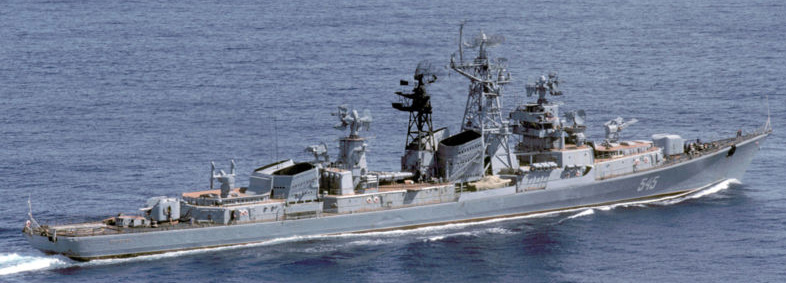
Kashin, October 1985
One of the paradoxes of these new gas turbines was their weight and their reduced size, which forced them to rethink stability, because of the weight in the heights: The superstructures were more compact, also for the sake of a more discreet radar signature. The Kashin were also the first Soviet ships to be equipped to survive a (relatively distant) nuclear explosion; they had compartmentalization with rooms with special anti-radiation walls, including for the gangway.
The Zderzhanny, the last of the 20 Kashin built, was completed in 1973 on a different design, and 5 others (the first Kashins) were modernized according to its new standard: 30 mm Gatling guns, new radars, ECM, 4×16 Wympel decoy launchers, 4 SSN-2c Styx cruise missiles in single ramps, new sonar, variable depth sonar in stern, enlarged superstructures, and a landing strip for helicopters at the rear (but no hangar).
The addition of weight was compensated for by the addition of solid ballast of 100 tonnes and additional tanks that were permanently filled. (4907 tonnes PC). Provornyy tested the new SAN-7 missile launcher in 1974-76. He remained the only one with this configuration.
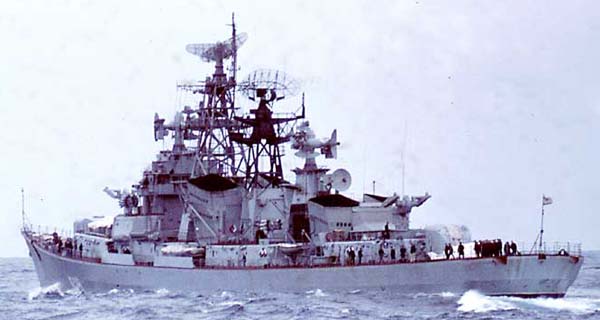
Kashin Class Destroyer Mediterranean January 1970
Other Kashins were built later, for India, 5 in all (Rajput class) between 1978 and 1985. They are still in service today. There were two losses in the class: One by accident, the Orel, ex-Otvazhnyy, in 1974, and the Smelyy, transferred in 1987 to Poland. Shortly before 1990, the Kashin’s career ended: Radiation in 1989: Ognevoy. In 1990: Oldarennyy, Provornyy and Stroynyy. 1991: Slavnyy, Komsomolets Ukraini. 1992: Sobrazitelnyy, Sposobny. 1993: Obraztsovyy, Steregushchiy, Smyshlennyy, Stroigiy. In 1995, there were still 5 in service in the early 1990s, the last built: Krasny Kavkaz, Reshitelnyy, Smetlivyy, Krasny Krim, Skoryy, Sderzhannyy. The latter have been placed in reserve, but their general condition has deteriorated.
All are now scrapped. The first, Komsomolets Ukrainy was decomm. in 1991, scrapped in 1995, and most followed the same years, until Project 61M Sderzhanny in 2001, scrapped in 2002 and the Polish ORP Warsawa, scrapped in 2005. The last active is Smetlivy, actove in the black sea fleet, because she had been modernized in the mid 1990s, with RBU-1000 launchers removed, eight SS-N-25 ‘Switchblade’ launchers fitted instead. The 1970s Indian Kashins however are still mostly active.

Author’s illustration of the Kashin class
The Indian Kashins
They were called the Project 61E (Rajput class), an export version for the Indian Navy (5 ships). This order, in the 1970s comprised fix ships:
INS Rajput (ex-Nadezhnyy) started at Mykolayiv Shipyard like all the others, on 11 September 1976, launched 17 September 1977 and completed 31 November 1979, INS Rana (ex-Gubitelnyy), INS Ranjit (ex-Lovkiy), INS Ranvir (ex-Tvyordyy) and INS Ranvijay (ex-Tolkovyy), completed on 15 October 1987. They are all still active in 2020 but INS Ranjit, decomm. in 2019.
Specifications
Displacement: 6700-7630t, 8565t FL
Dimensions: 173.5 x 18.50 x 5.32m
Propulsion: 2 shaft 4 DGC turbines, 120,000 hp. 32 knots max.
Crew: 380
Electronics: Radars 2 Don Kay, 1 Don 2, 1 Top Sail, Head-net C, 2 Head Light, 2 Pop group, 2 Owl Screech, 2 bass tilt. Sonar Blue Nose, Mare Tail, 8 CME Side Globes, 2/4 Rum Tub.
Armament: 2×4 missiles SSN14, 2×2 missiles SAN3, 2×2 missiles SAN4, 4 x 76 mm (2×2), 4 x AM 30 mm Gatling, 10 x 533 mm (2×5) TTs, 2 ASW RBU 6000 RL, 2 RBU 1000, 1 helicopter ASM Kamov Ka-25 Hormone.
 Udaloy class missile destroyers (1979-1998)
Udaloy class missile destroyers (1979-1998)
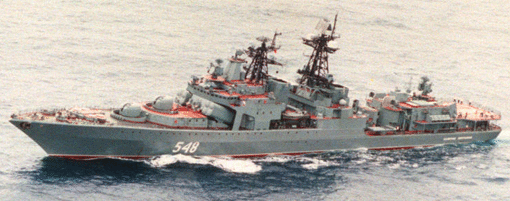
The Udaloy class missile destroyers (Project 956, Sarych) were designed as replacements for the Kotlin, and despite the cruiser’s dimensions and construction in the Kresta shipyards, were ED class by the Russians (Missile destroyers ). according to some sources indeed they are classified as cruisers, but this would suggest that the construction of destroyers in the USSR stopped with the last Kashin, in 1973. The problem is the same with the Udaloys. These are ships which by alliances bear the names of destroyers, not famous persons and great admirals or marshals.
Finally, they correspond in spirit to the new standards in this area also developed by the Americans with the Spruance and the Ticonderoga. The Sovremennyy were all built in Zhdanov, as soon as the holds were released in 1976 by the Yumashev (Kresta II). They also had the same hull and identical thrusters. They were then classified as ASM buildings. The design office (TTZ) which plancha on the project in 1970-71 defines a 5000 ton ship armed with a single AA gun, AA SA-N-4 missiles and ASM missiles in ramps, capable if necessary to carry out fire support operations, associated with the Ivan Rogovs thanks to their 130 mm guns suitable for coastal bombardment.
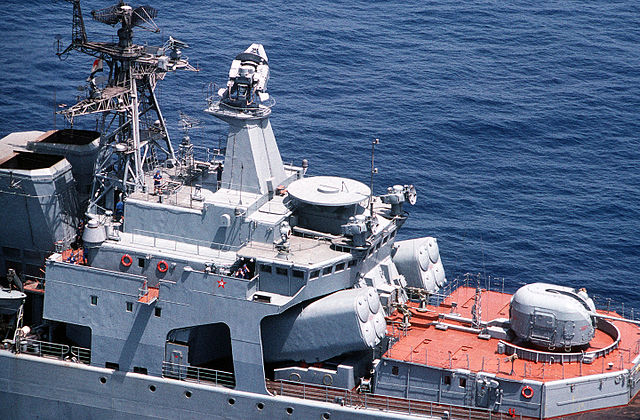
SS-N-14 on an Udaloy class vessel.
But the project was further reworked and following budgetary restrictions, leaned towards a frankly multirole mass-produced ship, of the “AEGIS” type, as in the US Navy. They had to be complementary to the Udaloy ASW.
The fact is that until 1990, there were 12 ships built, plus one that was never completed and another that same year 1990. There will be others: 6 units in 1991-97, but the two last, Vazhnyy and Nevskiy were left uncompleted for years before finding a buyer (China) in 2000. A total of 17 destroyers were active in the four fleets in the 1990s. Extra ships were built and sold abroad (project 956E), to India, notably.


Author’s illustration of the Udaloy class
Specifications
Displacement: 6200t, 7800t FL
Dimensions: 156 x 17.3 x 6.5 m
Propulsion: 2 shafts 2 DGC turbines, 4 HP heating, 100,000 hp. 35 knots.
Crew: 380
Electronics: Top Steer, 3 Palm Front, 6 Front Dome, 1 Kite Screech, 2 Bass Tilt. Sonar LF, 8 CME Bell, 2 LL.
Armament: 8 SSN-22 (2×4), 8 LM SAN-7 (48), 4 guns of 130 mm (2×2), 4 TLT 533 mm (2×2), 4 of 30 mm Gatling AM, 2 LR ASM RBU 1000 (12), 1 ASM Kamov Ka-27 Helix helicopter.
 Sovremennyy class destroyers (1978-2000)
Sovremennyy class destroyers (1978-2000)
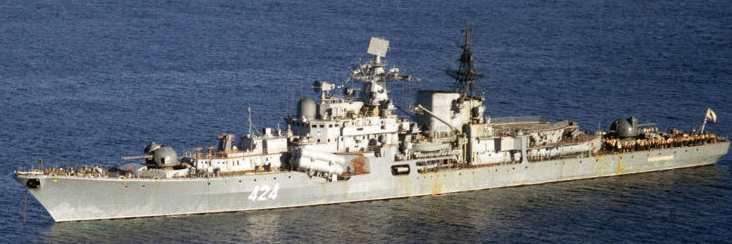
The Sovremennyy class missile destroyers (Project 956, Sarych) were designed as replacements for the Kotlin, and despite the cruiser’s dimensions and construction in the Kresta shipyards, were ED class by the Russians (Missile destroyers ). according to some sources indeed they are classified as cruisers, but this would suggest that the construction of destroyers in the USSR stopped with the last Kashin, in 1973.
The problem is the same with the Udaloy. These are ships which by alliances bear the names of destroyers, not famous persons and great admirals or marshals. Finally, they correspond in spirit to the new standards in this area also developed by the Americans with the Spruance and the Ticonderoga.
The Sovremennyy were all built in Zhdanov, as soon as the holds were released in 1976 by the Yumashev (Kresta II). They also had the same hull and identical thrusters. They were then classified as ASM buildings. The design office (TTZ) which plancha on the project in 1970-71 defines a 5000 ton ship armed with a single AA gun, AA SA-N-4 missiles and ASM missiles in ramps, capable if necessary to carry out fire support operations, associated with the Ivan Rogovs thanks to their 130 mm guns suitable for coastal bombardment.
But the project was further reworked and following budgetary restrictions, leaned towards a frankly multirole mass-produced ship, of the “AEGIS” type, as in the US Navy. They were to be complementary to the Udaloy ASMs.
The fact is that until 1990, there were 12 units built, plus one that was never completed and another that same year 1990. There will be others: 6 units in 1991-97, but the two last, Vazhnyy and Nevskiy were unfinished for years before finding a buyer (China) in 2000. A total of 17 class destroyers are active in the four fleets. It is not impossible that others are sold abroad (project 956E), to India for example, or to North Korea.

Author’s illustration of the Sovremenny class
Specifications
Displacement: 6200t, 7800t FL
Dimensions: 156 x 17.3 x 6.5 m
Propulsion: 2 shafts 2 DGC turbines, 4 HP heating, 100,000 hp. and 35 knots max.
Crew: 380
Electronics: Top Steer, 3 Palm Front, 6 Front Dome, 1 Kite Screech, 2 Bass Tilt. Sonar LF, 8 CME Bell, 2 LL.
Armament: 8 SSN-22 (2×4), 8 LM SAN-7 (48), 4 guns of 130 mm (2×2), 4 TLT 533 mm (2×2), 4 of 30 mm Gatliing AM, 2 LR ASM RBU 1000 (12), 1 ASM Kamov Ka-27 Helix helicopter.
 The return of destroyers: The controversial Lider class (2020+)
The return of destroyers: The controversial Lider class (2020+)
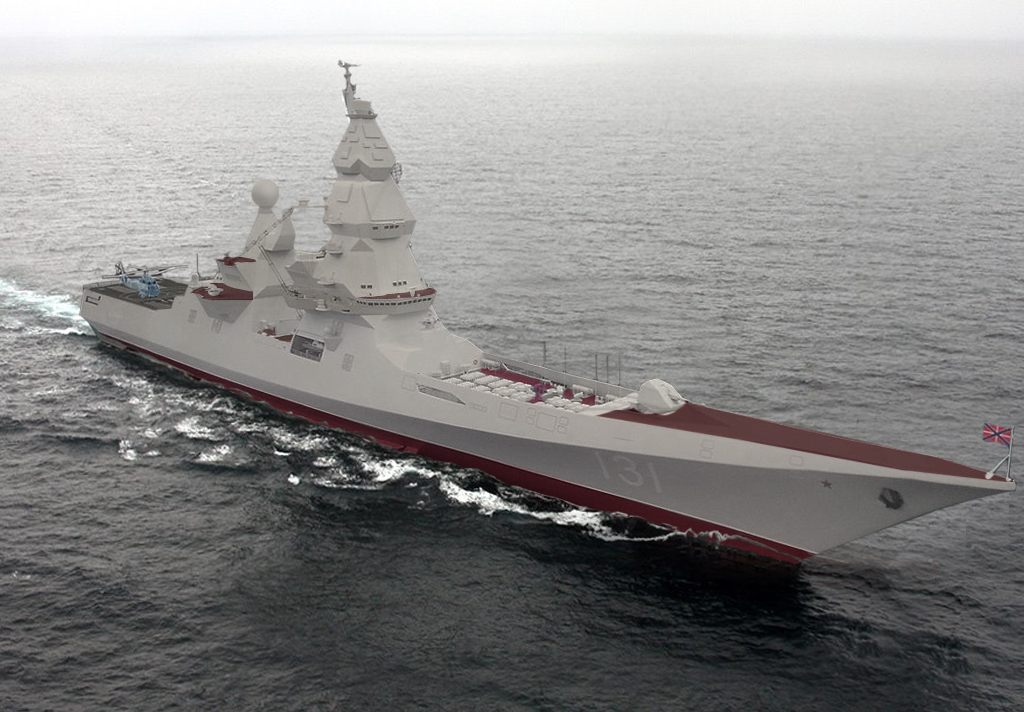
Montage of a lider class destroyer at sea, from the model exposed at «ARMY-2015» military-technical forum.
The design of the Sovremenny and Udaloy classes dated back from the mid-1970s, so after the fall of USSR, with long-lasting completions, the last in 1993, there was only a new batch of four for the Chinese PLAN, the Hangzhou class, completed between 1999 and 2006. But no destroyer project was coming forward due to the exonomic situation of the Russian Federation.
At last in 2013, as the Russian three armed branches were in rebuilt, a destroyer design project was approved and in 2015, were presented various design. Eventually Severnoye Design Bureau won the contract. The concept was to propose two designs, one of a non-nuclear, and one of an heavier nuclear-powered destroyer. The next year, the Krylov State Scientific Center had this design ready (apparently the large nuclear one), and twelve ships were planned, to be shared between the remaining Northern and Pacific fleets, later scaled down to eight vessels. A model of the nuclear-powered version was presented in 2015.
By May 2017, a report stated that the “Lider-class” was dropped from the FY 2018–2027 programme due to budgetary constraints. In June 2017 it bounced again as the Russian United Shipbuilding Corporation announced the Ministry approved a preliminary design for the Lider class destroyer, now officially called Project 23560.
In February 2019, the minustry approved the construction of the large, 19,000 ton nuclear-powered destroyer. The other variant was a non-nuclear 12-13,000 ton ship fitted with a gas turbine, and a completion date was advanced: The first two sister-ships were to be launched in the early 2020s for an estimated RUB100 billion apiece. 2023 was then the most likely date for laying the keel. By April 2020 the newspaper Interfax reported that Severnoye Design Bureau ceased any work on the Lider and Project 22350M frigates.
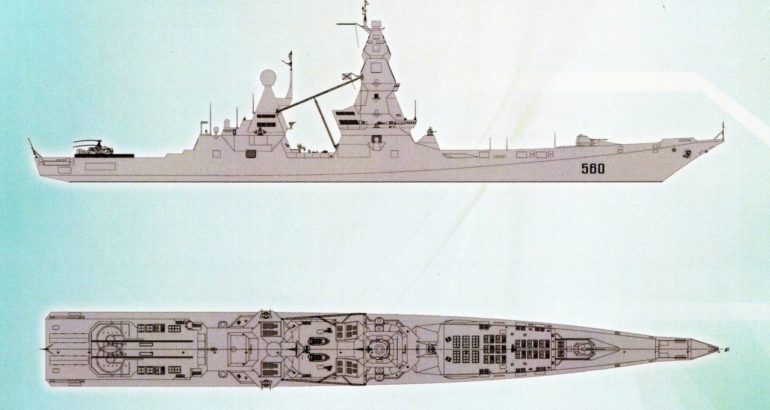
Wether this formidable-looking vessel, worthy of a cruiser and even the famous Kirov is ever built, the Krylov State Research Center Valeriy Polovinki stated the design was of a very versatile ship, a destroyer with large ASW capabilities but also a guided missile cruiser. The plan was to replace the ageing Sovremenny and Udaloy-class destroyers and Slava-class cruisers in one go.
Outside its large dimensions allowing to carry extra food storage and stores for 90 days of opeartions, the overall lenght was estimated to 230 metres (754 ft 7 in) long, not far from the Kirov, 20 metres (65 ft 7 in) wide, and 32 knots (59 km/h) as a top speed, for 19,000 tonnes, and housing 200 missiles in silos of many types (60 antiship cruise missiles, 128 antiaircraft guided missiles and 16 antisubmarine guided missiles provisionally), flight deck and hangar for two Ka-27/Ka-32 ASW helicopters.
Very ambitious and intimidating with its three-staged stealthy tower, the Lider class is somewhat of a prestige project, but due to Russia’s actual financial position, there is no certaintly about the ship to be ever completed in its shape. The classic-propulsion project appearance has yet to be revealed. The missiles are likely to be the Kalibr (SS-N-27 Sizzler) anti-ship model and the Oniks (SS-N-26 Strobile) and S-500 SAMs.

Is this the 12,000 tonnes conventional destroyer proposal ? (2016 exposition) src
The pre-draft design of a promising destroyer for the pacific area for the Russian Navy was approved by the High Command in 2013. Subsequently, it was decided to build ships of this project for the Russian fleet only in the version with a nuclear power plant. The order for the construction of the Leader destroyer will most likely go to the St. Petersburg Severnaya, which, after modernization, will be able to build ships and vessels up to 300-350 meters in length. The head of the United Shipbuilding Corporation, Alexei Rakhmanov, said that the enterprise would be ready to cut metal for a new project in early 2018. According to open data, the ship will have a displacement of about 17.500 tons, which brings it closer to the nuclear cruisers of Project 1144 “Orlan” (full displacement of 25,000 tons). It is also known that the “Leader” must reach a speed of 30 knots and operate for 30 days.
For ria.ru, 2020:
MOSCOW, July 10 – RIA Novosti. The construction of the newest destroyer Leader may begin in 2023, the technical project is now being developed by the Northern Design Bureau (PKB), Pavel Filippov, head of the Krylov State Scientific Center, said in an interview with RIA Novosti. The Krylov Center developed the concept and preliminary design of this ship and then transferred the work to Severnoye PKB to develop a technical design. “Yes, they (Severnoye PKB – ed.) Started somewhere in 2016-2017. The work is underway. It was just that initially it was planned to build a ship with a gas turbine installation, and there was a displacement of 12-13 thousand tons, then they said that nuclear power was needed, and its displacement immediately increased to 18 thousand tons. What is the final result, we still do not understand, this should be asked from the Northern PKB. And as far as I understand, in 2023 we should start building this “steamer” too, Filippov said.
See also and also this source.
Read More/Src
Conway’s all the world’s fighting ships 1947-1995
V.V. Kostrichenko, A.A Prostokishin (В.В.Костриченко, А.А.Простокишин): “Poyushchiye fryegaty”
Warship International Staff (2015). “Views from the Career of the Soviet Destroyer Bravyy”.
https://web.archive.org/web/20070901003358/http://www.atrinaflot.narod.ru/2_mainclassships/05_em_30bis/0_30bis.htm
http://russianships.info/eng/warships/project_30bis.htm
https://web.archive.org/web/20070611133532/http://www.atrinaflot.narod.ru/2_mainclassships/05_em_41/0_41.htm
http://russianships.info/eng/warships/project_56.htm
https://flot.com/publications/books/shelf/reddragon/26/index.php?print=Y
http://russianships.info/eng/warships/project_56m.htm
http://russianships.info/eng/warships/project_57bis.htm
http://ship.bsu.by/ship/100756
http://www.bharat-rakshak.com/NAVY/Ships/Active/181-Rajput-Class.html
https://www.globalsecurity.org/military/world/india/d-rajput.htm
http://ship.bsu.by/ship/100188
https://web.archive.org/web/20051104041256/http://home19.inet.tele.dk/airwing/ships/sovremen.htm
https://function.mil.ru/news_page/country/more.htm?id=12215891@egNews
https://ria.ru/20180727/1525453390.html
https://flotprom.ru/news/?ELEMENT_ID=138280
https://web.archive.org/web/20060822180006/http://www.sinodefence.com/navy/surface/sovremenny.asp
https://web.archive.org/web/20020206000602/http://www.janes.com/regional_news/asia_pacific/news/jdw/jdw020108_1_n.shtml
http://www.navyrecognition.com/index.php?option=com_content&view=article&id=3848
https://www.globalsecurity.org/military/world/russia/956.htm
https://web.archive.org/web/20160323235225/http://fas.org/man/dod-101/sys/ship/row/rus/956.htm
https://web.archive.org/web/20160423071128/http://warfare.be/db/catid/269/linkid/1743/
https://www.naval-technology.com/projects/udaloy-class/
http://news.bbc.co.uk/2/hi/americas/7768743.stm
http://www.navyrecognition.com/index.php?option=com_content&view=article&id=243
http://russianships.info/eng/warships/project_1155.htm
https://en.wikipedia.org/wiki/Kanin-class_destroyer
https://en.wikipedia.org/wiki/Soviet_Navy
https://en.wikipedia.org/wiki/Kashin-class_destroyer
http://fr.naval-encyclopedia.com/guerre_froide/US-Navy.php#ds
https://www.naval-encyclopedia.com/cold-war/soviet-navy

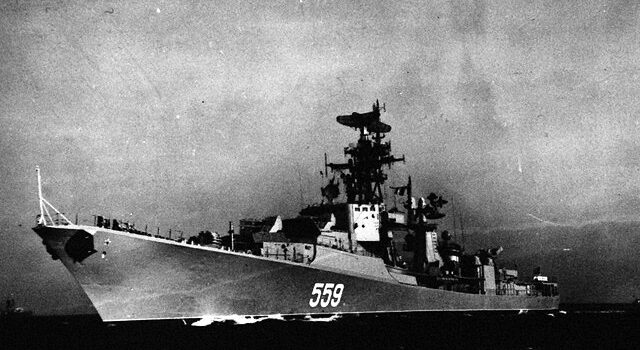

 Latest Facebook Entry -
Latest Facebook Entry -  X(Tweeter) Naval Encyclopedia's deck archive
X(Tweeter) Naval Encyclopedia's deck archive Instagram (@navalencyc)
Instagram (@navalencyc)





 Austrian Navy
Austrian Navy French Navy
French Navy Royal Navy
Royal Navy Armada Espanola
Armada Espanola K.u.K. Kriegsmarine
K.u.K. Kriegsmarine Dansk Marine
Dansk Marine Nautiko Hellenon
Nautiko Hellenon Koninklije Marine 1870
Koninklije Marine 1870 Marinha do Brasil
Marinha do Brasil Osmanlı Donanması
Osmanlı Donanması Marina Do Peru
Marina Do Peru Marinha do Portugal
Marinha do Portugal Regia Marina 1870
Regia Marina 1870 Nihhon Kaigun 1870
Nihhon Kaigun 1870 Preußische Marine 1870
Preußische Marine 1870 Russkiy Flot 1870
Russkiy Flot 1870 Svenska marinen
Svenska marinen Søværnet
Søværnet Union Navy
Union Navy Confederate Navy
Confederate Navy Armada de Argentina
Armada de Argentina Imperial Chinese Navy
Imperial Chinese Navy Marinha do Portugal
Marinha do Portugal Mexico
Mexico Kaiserliche Marine
Kaiserliche Marine 1898 US Navy
1898 US Navy Russkiy Flot
Russkiy Flot French Naval Aviation
French Naval Aviation Russian Naval Aviation
Russian Naval Aviation Sovietskiy Flot
Sovietskiy Flot Royal Canadian Navy
Royal Canadian Navy Royal Australian Navy
Royal Australian Navy RNZN Fleet
RNZN Fleet Chinese Navy 1937
Chinese Navy 1937 Kriegsmarine
Kriegsmarine Chilean Navy
Chilean Navy Danish Navy
Danish Navy Finnish Navy
Finnish Navy Hellenic Navy
Hellenic Navy Polish Navy
Polish Navy Romanian Navy
Romanian Navy Turkish Navy
Turkish Navy Royal Yugoslav Navy
Royal Yugoslav Navy Royal Thai Navy
Royal Thai Navy Minor Navies
Minor Navies Albania
Albania Austria
Austria Belgium
Belgium Columbia
Columbia Costa Rica
Costa Rica Cuba
Cuba Czechoslovakia
Czechoslovakia Dominican Republic
Dominican Republic Haiti
Haiti Hungary
Hungary Honduras
Honduras Estonia
Estonia Iceland
Iceland Eire
Eire Equador
Equador Iran
Iran Iraq
Iraq Latvia
Latvia Liberia
Liberia Lithuania
Lithuania Mandchukuo
Mandchukuo Morocco
Morocco Nicaragua
Nicaragua Persia
Persia San Salvador
San Salvador Sarawak
Sarawak Uruguay
Uruguay Venezuela
Venezuela Zanzibar
Zanzibar Warsaw Pact Navies
Warsaw Pact Navies Bulgaria
Bulgaria Hungary
Hungary

 Bundesmarine
Bundesmarine Dutch Navy
Dutch Navy Hellenic Navy
Hellenic Navy Marina Militare
Marina Militare Taiwanese Navy
Taiwanese Navy Chinese Navy
Chinese Navy Indian Navy
Indian Navy Indonesian Navy
Indonesian Navy JMSDF
JMSDF North Korean Navy
North Korean Navy Philippines Navy
Philippines Navy ROKN
ROKN IDF Navy
IDF Navy Royal New Zealand Navy
Royal New Zealand Navy Egyptian Navy
Egyptian Navy South African Navy
South African Navy

































 RN
RN
 Marine Nationale
Marine Nationale
 Soviet Navy
Soviet Navy
 dbodesign
dbodesign